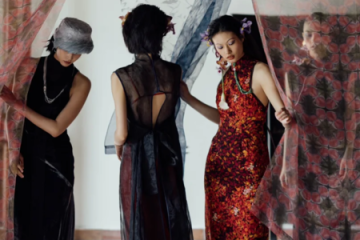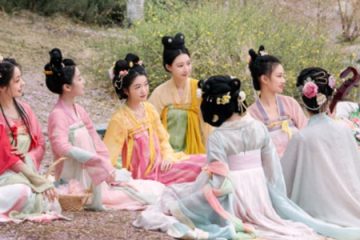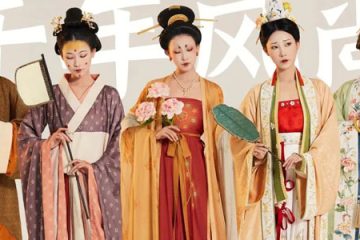What Are Chinese Girls’ Outfits Called?

If you’ve ever strolled through the streets of China, you’ve probably noticed how diverse women’s fashion can be—some dress in comfy, casual styles like students fresh out of class, while others carry a classical elegance (like Chinese hanfu), as if stepping out of a painting.
Chinese women truly have a wide range of styles to choose from. Today, let’s take a look at some of the most common outfits they wear and uncover the stories behind them.
Ⅰ. Everyday Casual Wear
1. Sporty Casual Style
For many Chinese girls, the top priority in everyday outfits is comfort—but that doesn’t mean they skip on style. Different types of casual wear fit seamlessly into all kinds of daily scenarios.
Wardrobe staples include sports hoodies, sweatpants, and lightweight jackets, usually made of cotton or polyester for a soft, skin-friendly feel. Whether it’s a quick grocery run, a stroll in the park, or a coffee catch-up with friends, these pieces are easy to wear and effortless to style.

In larger Chinese cities, where jogging and fitness have become popular, this look is especially common. Interestingly, many women don’t mind wearing“men’s styles” if they like the fit or design. Do women in your country also wear men’s clothing for casual fashion?

2. Sweet and Cute Style
When you see a Chinese girl in a dress, overall skirt, or peter pan collar blouse, chances are she’s going for that youthful “sweet girl” vibe. Dresses come in endless variations: in summer, floral prints with daisies or roses feel like wearing spring itself; in winter, cozy fleece-lined solid dresses keep things warm yet soft and feminine.
This style is especially popular among students. It’s perfect for dates, shopping trips, or casual hangouts with friends, always giving off a fresh, youthful energy on the streets.

Ⅱ. Traditional Style Clothing
1. Hanfu
The word Hanfu doesn’t just mean clothing from the Han Dynasty — it’s a broad term for the traditional dress of the Han people, spanning styles from pre-Qin all the way to the Ming and Qing dynasties.
Its most recognizable features are the crossed collar that folds right over left, wide flowing sleeves, and hidden ties instead of buttons. Each dynasty had its own look:
- Tang dynasty styles like the high-waisted ruqun (short top with skirt tied at the chest) were bold and colorful, like blooming flowers.
- Song dynasty outfits such as the beizi (long outer robe with loose sleeves) were simple and scholarly.
- Ming dynasty aoqun (short padded jacket with a long skirt) looked more dignified and practical for autumn and winter.

Today, Chinese hanfu has moved beyond museums. There’s even a “Hanfu Day” where young people wear it to scenic spots and exhibitions. TV dramas like The Longest Day in Chang’an and A Dream of Splendor have also boosted its popularity. Whether at school events or weddings, Hanfu has become a way for Chinese women to show cultural pride while keeping tradition alive.
2. Qipao (Cheongsam)
The origins of the qipao are debated, but it was redesigned in the 1920s into the body-hugging silhouette we know today. If cute, youthful outfits suit younger girls, the qipao is seen as a more elegant choice for grown women.
Its charm lies in its sleek lines, high mandarin collar, and decorative frog buttons. Lengths vary from knee to ankle, and fabrics range widely: silk qipaos give off a soft, refined shine for formal occasions, while cotton or linen versions are breathable and easy for everyday wear. Patterns often carry symbolism
—peonies and plum blossoms for beauty, dragons and phoenixes for good fortune.

Modern variations have appeared too: shorter hemlines, zippers replacing some frog buttons, or stretchy fabrics for comfort. (For example, the Heart Mead set in our store) Brides may choose a red qipao for weddings, while many women wear them to banquets or conferences as a mark of grace. Even visitors to China often buy one as a keepsake — the qipao has truly become an iconic symbol of Chinese fashion.
Summary
There’s no single “right answer” when it comes to what Chinese girls wear—it can be a comfy athletic hoodie, or an elegant Hanfu or Cheongsam; something casual for everyday wear, or something formal for special occasions.
Women can rock all kinds of styles and be whoever they want to be. Our website also sells Hanfu and Cheongsam in a variety of styles, helping you find the perfect one you love.
So, after reading this, which style of Chinese women’s clothing interests you the most? And if you had the chance to visit China, would you try wearing hanfu or qipao? Share your thoughts in the comments — let’s talk about the stories behind these beautiful clothes!



0 Comments